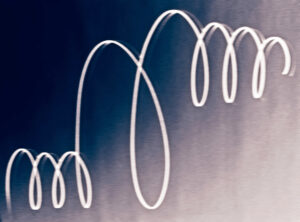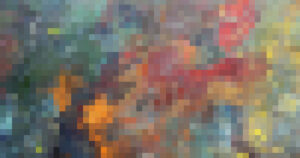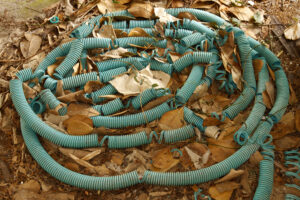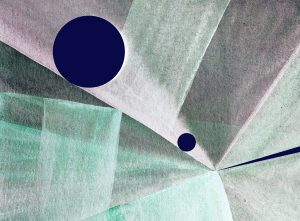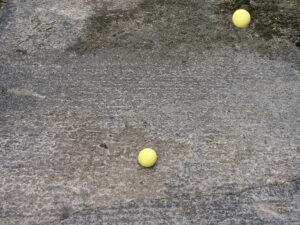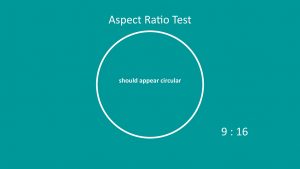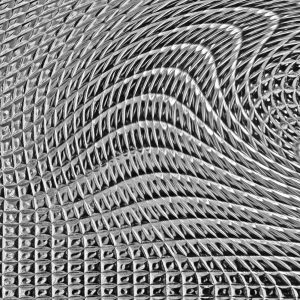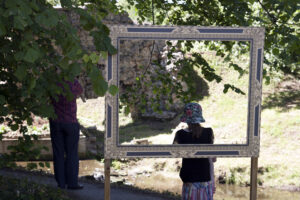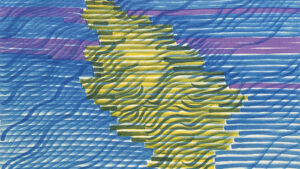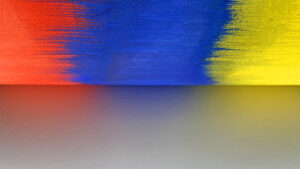
Video installation (video still)
Is there anything that is a truly static image? Certainly, when we talk about static versus moving images, there is a generally accepted definition which is useful to distinguish mediums but, still, are static images really static? Is the artwork of yesterday the same today in its seemingly static and unchangeable physical appearance or even in what it represents?
Comparing how painted, drawn or otherwise traditionally represented images look when they are first made to later in their life it is easy to identify changes in their physical appearance. If these images were truly static then restorers would be out of business. Time can be as great a detriment to artefacts as it can be a healer to emotions.
Talking of which, as attitudes and norms change over time the emotions evoked in viewers change too. That which was once reviled can become revered and the acceptable abhorrent. The avant-garde almost always becomes merely mainstream.
So neither form nor function remain static over time. On the other hand the wear and tear created by the passage of time, usage and exposure to the elements can add to its character and result in a different view being taken of an artefact, this is the basis of our collection of Time-Assisted Readymades.

Time-Assisted Readymade
The same is true of photographs as it is of other traditional forms of static image. Over time those produced with chemical processes can also deteriorate and those made with digital methods can find that the means of reproduction or viewing can also change coloration and resolution. All of which is leaving aside how easy it is to manipulate and distort the original digital presentation with well or mal intentioned purpose.
In representational art only a minority of works seek to portray life still. The vast majority are drawn as a moment in an ongoing course of events. In order to make the distinction, ever since the inception of traditional media such as painting even the earliest examples of cave drawings, artists have sought ways of depicting movement in their static works.
To do this there are some basic composition techniques taught early in art practice education. Chief amongst these is the use of direction to imply movement. This draws on how western tradition is to compose and view written material left to right and the psychological conditioning that results. One of many examples of this is from the 11th Century, in the Bayeux Tapestry.[1] The story unfolds from left to right over the length of the work and the vast majority of the animals, ships and people who are, in the story, in motion are facing to the right. Whether this is intuitive or deliberate is open to question but the overwhelming balance speaks to some underlying concept.
The psychology of this can be explored by looking at the work by Théodore Géricault, The 1821 Derby at Epsom.[2] Viewed as painted, with the horses facing left you tend to see it as a point frozen in time as the horses are in front of the viewer. Reverse the image and the perception is changed, movement is implied and they appear to be going away from you at pace.
In static images actual movement remains just an illusion, depicted in a way designed to mimic the feeling we get from different actions and their speed and duration in real life.
Another way that movement is depicted and analysed is by charting the successive positions of a point over time, using intricate camera work and settings to avoid blurring, thus capturing of each stage of a gesture or movement which can then be presented as a diagram.
Prime examples of this are the works of Etienne-Jules Marey[3] and Eadwerd Muybridge,[4] showing a series of stages of a movement conflated into a ‘Chronogram’.
Artist Marcel Duchamp drew on this method when he created the seminal ‘static’ work Nude Descending a Staircase, No. 2,[5] considered outrageous by many in the establishment at the time, which can also be described as a chronogram.
Ultimately the strong desire to perfect the depiction of movement in static images lead, via photography and chronograms, into the establishment of the medium of the motion picture. The irony in this is that ‘movies’ are actually just a long series of static images played in quick succession to complete the illusion of movement.
Video installation (fragment)
This new medium did make the depiction of movement much easier and also gave greater control to creators over movement, it’s not a coincidence that the prime creators are called directors. However, with the gaining of control of movement what was lost, for the viewer at least, was the control of time. With a static image it is up to the viewer to determine how long to dwell on it, when to move on and even when to return to it. As the art historian and writer Ian Jeffrey[6] put it in a conversation about the relative merits of static photographic images and video installations “How long do you look at a video?”
Whilst it is still true that the viewer can chose when to return for a second viewing, with a motion picture the viewing time is in the hands of the director and editor. Many a splendid performance by an actor or actress lies unseen on the cutting room floor.
Also, the speed of the cut from shot to shot selected by the creator becomes a compositional element which massively affects the response of the viewer. This represents a significant shift in the balance of power between artist and viewer.
The degree of power in the hands of the viewer is important when we return to the consideration of just how static single images are. Every static image does essentially present a single moment in time. However, the viewer comes to it with their own experience and in a context of prevailing norms and expectations.
As a result, a static image often provokes thoughts about what came before and what will happen next. This in turn leads to a consideration of the meaning of ‘permanent’. The Oxford Dictionary defines permanent thus: “lasting or intended to last or remain unchanged indefinitely.”
Perhaps the best illustration of such an intent are buildings. How long are they intended to last is one question, but another is what do we see when examine an image of a building, how much do we see as we dwell on it and what do we as a viewer imagine about the past and future of the building.
The immediate response might well be to the form of the building itself, how we regard the architectural merit and its relation to the locale. This is akin to how most viewers will first respond to any static image. The immediate reaction will relate to their preferences and the context in which it is encountered.
However, if the viewer is familiar with the locale then in the first instance it might be a reflection on a memory of the view before the building existed and even if not we can speculate about aspects of how the location was previously. Perhaps less thought is given to what might replace it, but thoughts about future repairs, renovation and extension could easily come to mind.

Looking at the detail of the image above, there are clues both to the past and future. Previous repairs and enhancements are evident, there are indications of missing elements which may be replaced and of some where future repairs might be made. Even elements which may not endure – How many fewer television ariels are there now than 30 years ago? Yet every element when built was intended to last.
Finally to the future of the building itself. It has stood for a considerable time and its owners will expect it to last for many years to come. I’m sure the same was felt by the majority of the residents of both Pompeii and Mariupol.
[1] The Bayeux Tapestry, Tapisserie de Bayeux or La telle du conquest (French); Tapete Baiocense (Latin) is
embroidered cloth nearly 70 metres (230 ft) long and 50 centimetres (20 in) tall that depicts the events leading up to theNorman Conquest of England in 1066.
[2] The 1821 Derby at Epsom traditionally called Le Derby de 1821 à Epsom) is an 1821 painting by Théodore Géricault (1791 – 1824) in the Louvre Museum.
[3] Etienne-Jules Marey (1830 – 1904) was a French scientist, physiologist and chronophotographer.
[4] Eadwerd Muybridge (1830 – 1904), born Edward James Muggeridge was an English photographer known for his pioneering work in photographic studies of motion, and early work in motion-picture projection.
[5] Nude Descending a Staircase, No. 2 (French: Nu descendant un escalier n° 2) is a 1912 painting by Marchel Duchamp.
[6] Ian Jeffrey is an English art historian, writer and curator. He is the author of a series of illustrated books on the history of photography.
